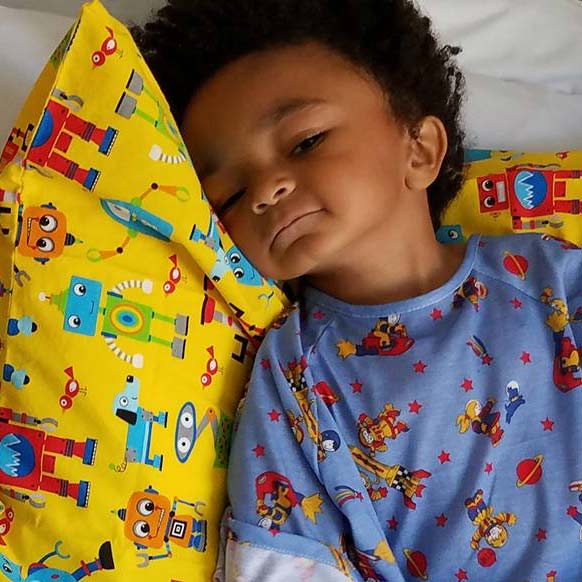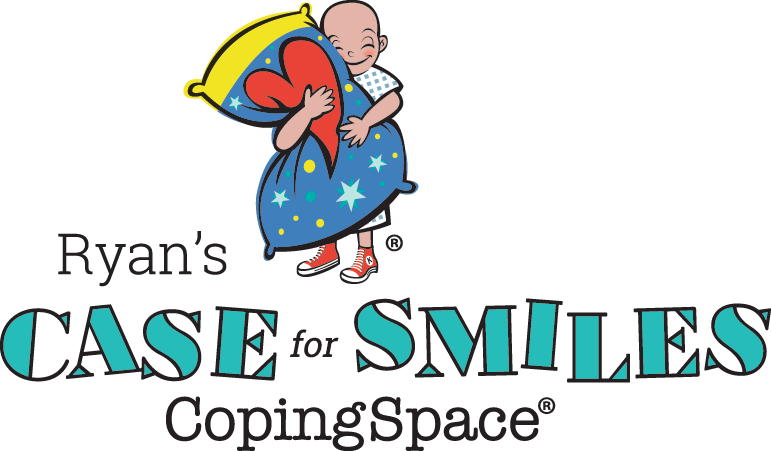YOUNG CHILDREN
Infants and young children rely on their parents and the adults around them to provide a sense of safety and security, as well as trusted routines. Your young child can seem to “bounce back” to a calmer or happier state, even after upsetting or painful moments in treatment, when you are there to provide distraction, security, and comfort.
Infants and young children rely on their parents and the adults around them to provide a sense of safety and security, as well as trusted routines. Your young child can seem to “bounce back” to a calmer or happier state, even after upsetting or painful moments in treatment, when you are there to provide distraction, security, and comfort.
 When they are upset, young children tend to SHOW you, rather than tell you. It’s best to watch for changes in their behavior to understand how they are feeling and coping. For example, young children:
When they are upset, young children tend to SHOW you, rather than tell you. It’s best to watch for changes in their behavior to understand how they are feeling and coping. For example, young children:
- Can regress in behaviors (bed-wetting, thumb-sucking, etc.) in response to distress.
- May have strong startle responses (being jumpy, frightened, or surprised), nightmares, and outbursts.
- Are still developing their ability to use words to process their feelings, and so are more likely to process the illness or injury through play, drawing, and storytelling.
- Depend on parent presence and support to soothe and calm them, because they are still developing the ability to self-soothe.
- May be affected by what they sense from caregivers and others.
- Can experience the sights, sounds, or smells of the medical environment as stressful and/or traumatic.
- May get angry or frustrated with doctors and nurses administering painful procedures.
- Can experience separation from parents, siblings, and/or pets as traumatic.
- May not understand that some losses are permanent.
 When they are upset, young children tend to SHOW you, rather than tell you. It’s best to watch for changes in their behavior to understand how they are feeling and coping. For example, young children:
When they are upset, young children tend to SHOW you, rather than tell you. It’s best to watch for changes in their behavior to understand how they are feeling and coping. For example, young children:
- Can regress in behaviors (bed-wetting, thumb-sucking, etc.) in response to distress.
- May have strong startle responses (being jumpy, frightened, or surprised), nightmares, and outbursts.
- Are still developing their ability to use words to process their feelings, and so are more likely to process the illness or injury through play, drawing, and storytelling.
- Depend on parent presence and support to soothe and calm them, because they are still developing the ability to self-soothe.
- May be affected by what they sense from caregivers and others.
- Can experience the sights, sounds, or smells of the medical environment as stressful and/or traumatic.
- May get angry or frustrated with doctors and nurses administering painful procedures.
- Can experience separation from parents, siblings, and/or pets as traumatic.
- May not understand that some losses are permanent.

Signs Your Young Child May Not Be Coping Well
Below are a few signs your child may be having trouble coping. If these go on for more than a few weeks, or interfere with your child’s everyday life, you may want to seek additional help from their doctor.
Watch to see if your child:
- Wants to be alone or to be with you all the time
- Becomes easily overwhelmed, jumpy or irritable
- Changes their behavior, becoming more sensitive, quiet, or talking back and getting in to fights
- Has trouble sleeping or has nightmares
- Misses friends or feels left out
- Develops problems in school
Ways to Help Young Children
To best help your child(ren), look at the big picture and consider:
- What are things that you need as a caregiver?
- What information do the children need to be made aware of?
- What resources are available along the way to help?
This will help you make a plan for supporting your entire family. It is important to look at what was in place prior to the illness or injury, and assess what is still manageable and what needs to be changed or eliminated.
As much as possible, maintain everyday routines, activities, and limits (like meal times, bed times, and chores). These give young children things to expect and look forward to, and can help things feel more normal at home. Also be sure to talk about things other than the illness or treatment.
It is common for children to regress during stressful times. Try your best not to get upset. Young children are also learning new skills and increasing their independence. Give them choices whenever possible, such as what book to read.
Preparing Your Child for the Hospital or Procedures
Your child will do best when they are prepared for whatever they will encounter. Children learn using their 5 senses so explain what they may hear, see, feel, smell and taste. To help, look for books, TV shows, etc. to make them familiar with helpers in the hospital or doctor’s office. Suggestions can be found here.
For specific procedures, try having them feel the medical equipment that will be used to help them to get better. Can they touch the IV tubing, blood pressure cuff or the pulsox probe?
Speak first with a child life specialist, nurse or doctor about what to expect and ways to help them cope. And try not to prepare your child too far in advance as this may cause them to worry.

Helpful Phrases
- “You will have to stay overnight in the hospital so that you can get the medicines your body needs. These are medicines that mom/dad cannot give you at home.”
- “Sometimes kids have to go to the hospital to get the medicine that their body needs. You are going to go to the hospital but we are not planning on staying overnight. Instead, we will go to the doctor’s office at the hospital, it’s called the clinic. At the clinic you will be cared for by nurses and doctors who will check you out and give you the medicines that you need.”
- “In the hospital there are a lot of machines that the hospital workers use to try to help a person’s body. Sometimes they can sound, smell or look different. If we see something that we do not know about, let’s ask so it is not so scary.”
- Types of Hospitals
• Children’s Hospital: “We need to go to the hospital so you can get your medicines. This hospital is just for kids.”
• Pediatric Floor in an Adult/Community Hospital: “We need to go to the hospital so you can get your medicines. This hospital has an area where kids, like you, are helped.”
• Community Hospital Without a Pediatric Floor: “We need to go to the hospital so you can get your medicine. This hospital cares for grown-ups and kids. The doctors and nurses know how to help kids, like you.”
- Talk to your child about why the procedure is necessary: “The pinch may hurt for a few seconds. The medicine given at that time should help the pain to stay away for a while.”
- Describe things to your child using the 5 senses. “This cuff will be put around your arm and you will feel it giving your arm a squeeze.” Follow this up by telling them what their job is. “Your job is to hold still while it is squeezing your arm.”
- Try to avoid the word “okay” after a sentence. This could imply that your child has a choice, when they may not.
• For example: “We need to go to the hospital to get your medicine, okay?”
- Be careful of the word “just” as your child may feel that their feelings are not validated. In some cases your child may be showing a reaction to what they think is going to happen or how something may feel. At other times the fear of pain may be real to them.
• For example: “It is just tape coming off of your skin.” Your child may not like the feeling of tape being removed from their skin and it may cause them a little discomfort.
Supporting Young Children at the Hospital and Clinic
- If your child has a comfort object, try to have it present at appointments and the hospital.
- If possible, try to have someone who your child knows stay at the hospital at times when you are unable to be there.
- Bring pictures of your family and pets for your child’s hospital room.
- Does your child find comfort in hearing their favorite book or song? Or, is there another routine that helps your child cope? Let the hospital staff know so they can try to use those methods when you are not able to be at your child’s bedside.
- Talk to your child’s nurse about using the treatment room, if possible, for any and all procedures. This way their hospital room can be a “safe” space. Some hospitals may not have treatment rooms, the treatment rooms may be unavailable, or you child may not be able to leave their room. In these cases, the procedure may have to be done at their bedside.
- Distraction is often the best way you can help a child during an injection or other procedure. Help them look at, think about, and get involved in something else. You might have your child blow bubbles, blow to spin a pinwheel, look at a game on your phone – anything that engages their attention.
- It may seem odd, but saying reassuring things to your child, like “It will only hurt a little”, “You are so brave with this pain”, or “I am so sorry this is hurting you”, has actually been shown to increase pain or distress during a procedure. So focus on distraction, and praise your child for SPECIFIC things they are doing. (“Great job holding still and focusing on the game!”)
- You can learn more about distraction, and how to use this technique, in these “Distraction in Action” videos.
- You can also sign up for the free Distraction in Action Tool that provides recommendations on how to use distraction based on your individual child.
Tips for Talking With Young Children
- When talking with your child, get down at their eye level. It will help make them feel comfortable.
- Be open and honest, using words they can understand. Call the illness by its name (cancer, diabetes, etc.).
- Ask your child what they know about the illness or injury. This will help you learn what they are thinking (you might be surprised by what they understand, or misunderstand), and will give you a place to start. Also ask them what they know about the hospital or clinic.
- Remember that your child will not be able to handle a lot of information at once. You may want to break it down to a few mini conversations, addressing only the things that are relevant at the time.
- Reassure them that they did not get sick because of anything that they said or did. (If the illness or injury was due in part to something that was done, omit this statement, or emphasize what they are doing now to help themselves get better.)
- Encourage your children to share their feelings. There are many ways to share feelings (talking, drawing, storytelling, hugging) at different times (dinnertime, bedtime) and places (in the car, at home, in the hospital). There are some good books or activities to try in our Resources section. For example, Play Doh is good for helping to work out angry feelings.
- Help you child name their feelings, such as being sad, scared, angry, jealous, or guilty, and let them know it’s okay. Encourage them to talk to you when they feel upset and be a good listener even if what they have to say is hard to hear.
- Share your own feelings and things that help you cope.
- End each talk by asking your child if they have any questions. Encourage them to ask questions, not only of you but also the healthcare staff.
- For more tips on having difficult conversations, read How to Share Bad News with Your Child.
Useful Phrases to Use With a Young Child
You know your child best, and you probably have experiences which you can draw on to talk with them about things that are hard or challenging. The child life specialists, doctors and nurses may also have specific suggestions for how to explain your child’s illness or treatment in child-friendly terms. Here are some additional suggestions to get you started. General:
General:
- “How are you doing? Is there anything that you are worried or scared about? When I am worried I think it is helpful to talk to someone.”
- “If you feel like you don’t want to talk right now, how about drawing a picture about what is happening and what you are feeling?”
Hospital/Clinic:
- “The hospital/clinic is a new place for all of us. If there is something that you aren’t sure about or that scares you, please let me (us) know so we can talk about it.”
- “The hospital/clinic is a new place for all of us. There are some things that the doctors and nurses will need us to do to try to help your body. You can help too!”
- “There are a lot of people who work in the hospital/clinic. They are there to help. If there is something that you do not know, ask them. It’s part of their job to answer your questions!”
- “The hospital/clinic can be a scary place because it’s new and there are new people. All of the people who work in the hospital/clinic are there to help. They care for a lot of kids each day.”
- Try to avoid the word “take”, as young children may think that something is leaving them. Example: “The nurse is going to take your temperature.” Try saying, “The nurse is going to check your temperature.”
- “Sometimes, to best help you, the nurses or doctors have to check out your body, or give you medicines that can only be given at the hospital/clinic.”
- “Some medicines have to be given by using a needle. It may feel like a pinch. Your job is to hold still, and I can help you think about something else while it happens. You can choose to (hold my hand, look at a book) while the nurse/doctor does their job.”
- Note: Find out from the child life specialists, nurses and doctors what to expect, and choose your words accordingly. It is important not to make promises (e.g. it will only be a small pinch) that are not realistic.
